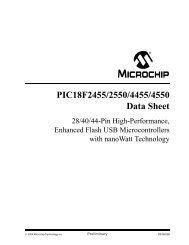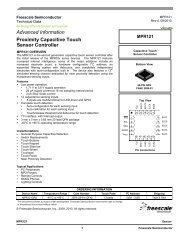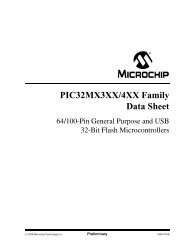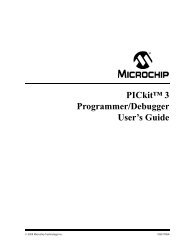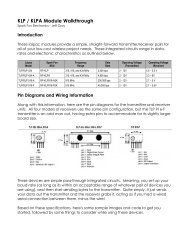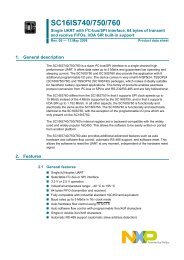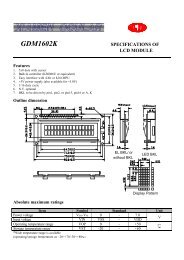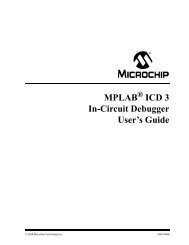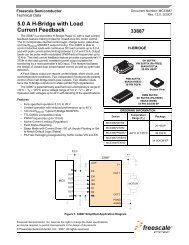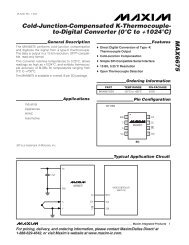PIC24HJ64 Datasheet
PIC24HJ64 Datasheet
PIC24HJ64 Datasheet
You also want an ePaper? Increase the reach of your titles
YUMPU automatically turns print PDFs into web optimized ePapers that Google loves.
PIC24HJ32GP302/304, <strong>PIC24HJ64</strong>GPX02/X04, AND PIC24HJ128GPX02/X04<br />
9.2.2 IDLE MODE<br />
The following occur in Idle mode:<br />
• The CPU stops executing instructions.<br />
• The WDT is automatically cleared.<br />
• The system clock source remains active. By<br />
default, all peripheral modules continue to operate<br />
normally from the system clock source, but can<br />
also be selectively disabled (see Section 9.4<br />
“Peripheral Module Disable”).<br />
• If the WDT or FSCM is enabled, the LPRC also<br />
remains active.<br />
The device wakes from Idle mode on any of these<br />
events:<br />
• Any interrupt that is individually enabled<br />
• Any device Reset<br />
• A WDT time-out<br />
On wake-up from Idle mode, the clock is reapplied to<br />
the CPU and instruction execution begins immediately,<br />
starting with the instruction following the PWRSAV<br />
instruction, or the first instruction in the ISR.<br />
9.2.3 INTERRUPTS COINCIDENT WITH<br />
POWER SAVE INSTRUCTIONS<br />
Any interrupt that coincides with the execution of a<br />
PWRSAV instruction is held off until entry into Sleep or<br />
Idle mode has completed. The device then wakes up<br />
from Sleep or Idle mode.<br />
9.3 Doze Mode<br />
The preferred strategies for reducing power<br />
consumption are changing clock speed and invoking<br />
one of the power-saving modes. In some<br />
circumstances, this cannot be practical. For example, it<br />
may be necessary for an application to maintain<br />
uninterrupted synchronous communication, even while<br />
it is doing nothing else. Reducing system clock speed<br />
can introduce communication errors, while using a<br />
power-saving mode can stop communications<br />
completely.<br />
Doze mode is a simple and effective alternative method<br />
to reduce power consumption while the device is still<br />
executing code. In this mode, the system clock<br />
continues to operate from the same source and at the<br />
same speed. Peripheral modules continue to be<br />
clocked at the same speed, while the CPU clock speed<br />
is reduced. Synchronization between the two clock<br />
domains is maintained, allowing the peripherals to<br />
access the SFRs while the CPU executes code at a<br />
slower rate.<br />
Doze mode is enabled by setting the DOZEN bit<br />
(CLKDIV). The ratio between peripheral and core<br />
clock speed is determined by the DOZE bits<br />
(CLKDIV). There are eight possible<br />
configurations, from 1:1 to 1:128, with 1:1 being the<br />
default setting.<br />
Programs can use Doze mode to selectively reduce<br />
power consumption in event-driven applications. This<br />
allows clock-sensitive functions, such as synchronous<br />
communications, to continue without interruption while<br />
the CPU idles, waiting for something to invoke an<br />
interrupt routine. An automatic return to full-speed CPU<br />
operation on interrupts can be enabled by setting the<br />
ROI bit (CLKDIV). By default, interrupt events<br />
have no effect on Doze mode operation.<br />
For example, suppose the device is operating at<br />
20 MIPS and the ECAN module has been configured<br />
for 500 kbps based on this device operating speed. If<br />
the device is placed in Doze mode with a clock<br />
frequency ratio of 1:4, the ECAN module continues to<br />
communicate at the required bit rate of 500 kbps, but<br />
the CPU now starts executing instructions at a<br />
frequency of 5 MIPS.<br />
9.4 Peripheral Module Disable<br />
The Peripheral Module Disable (PMD) registers<br />
provide a method to disable a peripheral module by<br />
stopping all clock sources supplied to that module.<br />
When a peripheral is disabled using the appropriate<br />
PMD control bit, the peripheral is in a minimum power<br />
consumption state. The control and status registers<br />
associated with the peripheral are also disabled, so<br />
writes to those registers do not have effect and read<br />
values are invalid.<br />
A peripheral module is enabled only if both the<br />
associated bit in the PMD register is cleared and the<br />
peripheral is supported by the specific PIC MCU<br />
variant. If the peripheral is present in the device, it is<br />
enabled in the PMD register by default.<br />
Note:<br />
If a PMD bit is set, the corresponding module<br />
is disabled after a delay of one instruction<br />
cycle. Similarly, if a PMD bit is cleared,<br />
the corresponding module is enabled after<br />
a delay of one instruction cycle (assuming<br />
the module control registers are already<br />
configured to enable module operation).<br />
DS70293B-page 124 Preliminary © 2008 Microchip Technology Inc.



